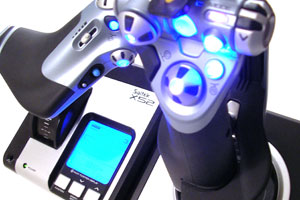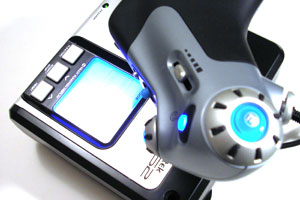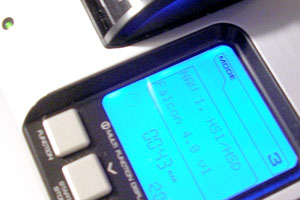
Saitek X52 Review
Plugging in the Saitek X52

So it's time to fire up the X52. Loading the drivers and programming softwar eand then pluging in the Saitek X52 was all very easy and straightforward. First time, no problem, lovely job.
The first thing you notice is the X52 is pretty with it's neo-retro-futurism (yep I made that up -- it means that it looks futuristic in a modern way, but with some reto touches). Once it's powered up with all those blue LEDs and the backlit LCD screen it's a real viusual treat -- a very sexy piece of kit. But looks are nothing if it doesn't work.
OK, now to fly. I load up my trusty Falcon 4, go into the setup screen, point the controller at the Saitek X52's axis (axes I think is correct pluralisation of axis, but I never have been able to use it) and then I hit FLY. To my surprise and delight, most of the buttons are recognised as DirectX buttons so my PC recognises they're at least there without any programing. It doesn't make much difference, because Falcon is too complex and without programing the buttons they're largely useless.
 But the stick is gorgeous. It's light and nimble with very low resistance -- even less resistance than the ST290PRO. This has it's advantages and disadvantages. It's really easy to make small adjustments to your flight, but if you're in the heat of battle you tend to overuse the stick and end up barrel-rolling to your doom.
But the stick is gorgeous. It's light and nimble with very low resistance -- even less resistance than the ST290PRO. This has it's advantages and disadvantages. It's really easy to make small adjustments to your flight, but if you're in the heat of battle you tend to overuse the stick and end up barrel-rolling to your doom.
The rudder, unlike it's predecessor's (the X45) rocker switch, is a twist grip.I'm used to this with the ST290 anyway so it didn't make any difference to me. If you have rudder pedals (or intend to purchase some at some point), the twist function can be stopped by pulling a plastic tab at the base of the stick. This locks the stick, stopping it from rotating. If you simply must have the rudder set up as on your X45, then the precision slider on the throttle can probably be programmed as the rudder.
Both the pinkie switch and the trigger are metal (at least they're supposed to be -- I have my suspicions that they may not be, but I'm not a metalurgist) and the trigger is a two-stage switch. This may or may not be useful. In WWII flight sims I could see this as being good for firing machine guns to line up on the target, and then once lined up pulling the trigger full in to get those cannons blazing.
I was actually fairly surpised that it wasn't that easy to accidently get to the second stage of the trigger. In my first profile I set the trigger up to assign a target at stage one, and fire the 20mm at stage two. I didn't once fire accidently when targeting. Nicely done.
The only downside was that the stick was just too big for my hand, but it is adjustable in terms of where the handrest sits. A thumbscrew allows you to raise the rest up or down, taking the pinky switch with it. However, I found that if I had the handrest in it's highest position(which was the best place for my thumb to reach the buttons and hats on the top of the stick) I didn't have room between the pinky switch and the trigger for my other fingers.
After a bit of fiddling a compromise was reached. Now it's set up as best as can be. There's room for my fingers and most of the top buttons are reachable, but flipping the safety cover of the missile/bomb/pickle switch is a little awkward.
 The throttle was real nice. It was just plain good to be able to sit in a comfortable position rather than having to contort so I could reach the throttle at the back of the ST290 PRO. The throttle has detents for idle and afterburner/mil power setting and adjustable tension on the throttle arm itself. You can slacken it off or tighten it up according to your preference simply by using a thumbscrew on the side of the unit. Tightening it up is when you discover why Saitek supplied you with the suction cups. If you push real hard either forward or backward you will rock the throttle off balance. The same goes with the stick. Neither of the units have the weight or balance you'd like.
The throttle was real nice. It was just plain good to be able to sit in a comfortable position rather than having to contort so I could reach the throttle at the back of the ST290 PRO. The throttle has detents for idle and afterburner/mil power setting and adjustable tension on the throttle arm itself. You can slacken it off or tighten it up according to your preference simply by using a thumbscrew on the side of the unit. Tightening it up is when you discover why Saitek supplied you with the suction cups. If you push real hard either forward or backward you will rock the throttle off balance. The same goes with the stick. Neither of the units have the weight or balance you'd like.
But that's nothing a couple of 3" wood-screws couldn't solve. In fact, that's what a lot of owners do -- rig up a platform for their Saitek X52 and bolt the whole contraption to their seat. Both the throttle and stick have holes drilled through their base, I suspect, just for this purpose.
Other than the balance and sensitivity of the stick, I must say I was impressed with my first basic flight. It sure was a whole lot easier to control the F16 with the X52 than the ST290 and gave a much more immersive experience. But then it should ... it's more than 3 times the price. Is it worth this price on looks and immersion alone?
The real reason I got the X52 was for all the buttons, rotaries, hats and other stuff it has. Time to program.
|
|
|
(c) 2007 IndiVision Studios, All rights reserved.